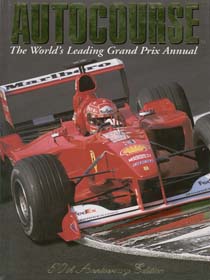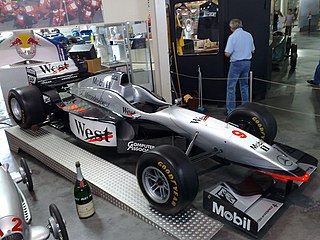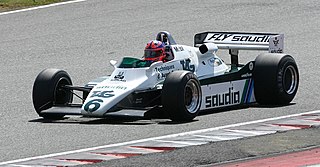Related Research Articles

GP Racing, formerly F1 Racing, is a monthly magazine focused on Formula One racing that launched in March 1996.
Panasonic Toyota Racing was a Formula One team owned by the Japanese automobile manufacturer Toyota Motor Corporation and based in Cologne, Germany. Toyota announced their plans to join Formula One in 1999, and after extensive testing with their initial car, dubbed the TF101, the team made their debut in 2002. The new team grew from Toyota's long-standing Toyota Motorsport GmbH organisation, which had previously competed in the World Rally Championship and the 24 Hours of Le Mans. Despite a point in their first-ever race, Toyota never won a Grand Prix, their best finish being second, which they achieved five times.

The 1995 British Grand Prix was a Formula One motor race held on 16 July 1995 at Silverstone Circuit, Silverstone, Northamptonshire, England. It was the eighth round of the 1995 Formula One World Championship. Johnny Herbert for the Benetton team won the 61-lap race from fifth position. Jean Alesi finished second in a Ferrari, with David Coulthard third in a Williams car. The remaining points-scoring positions were filled by Olivier Panis (Ligier), Mark Blundell (McLaren) and Heinz-Harald Frentzen (Sauber). Herbert's victory was his first in Formula One, and the Benetton team's fifth of the season.

The 1995 Italian Grand Prix was a Formula One motor race held on 10 September 1995 at the Autodromo Nazionale di Monza, Monza, Italy. It was the twelfth race of the 1995 Formula One World Championship.

The 1995 FIA Formula One World Championship was the 49th season of FIA Formula One motor racing. It featured the 1995 Formula One World Championship for Drivers and the 1995 Formula One World Championship for Constructors, which were contested concurrently over a seventeen-race series that commenced on 26 March and ended on 12 November.
Alan Henry was a British Grand Prix reporter and book author.

The McLaren MP4/13 was the car with which the McLaren team competed in the 1998 Formula One World Championship. The chassis was designed by Adrian Newey, Steve Nichols, Neil Oatley and Henri Durand, with Mario Illien designing the bespoke Ilmor engine. Driven by Mika Häkkinen and David Coulthard, the MP4/13 proved to be the dominant car of the season, with Häkkinen winning eight races en route to his first Drivers' Championship, while McLaren won their first Constructors' Championship since 1991 and, as of May 2024, their last.

The Ferrari F399 was the car with which the Ferrari team competed in the 1999 Formula One World Championship. The chassis was designed by Rory Byrne, Giorgio Ascanelli, Aldo Costa, Marco Fainello, Willem Toet, and Nikolas Tombazis, with Ross Brawn playing a vital role in leading the production of the car as the team's technical director and Paolo Martinelli assisted by Giles Simon leading the engine design and operations.

Autocourse is a series of annuals covering motor racing, and Formula One in particular. The annuals cover a long period of the sport's history, from 1951 to the present day, and, as such, are highly collectable.

The McLaren MP4/12 was the Formula One car with which the McLaren team competed in the 1997 Formula One World Championship. The chassis was designed by Steve Nichols, Neil Oatley and Henri Durand with Mario Illien designing the bespoke Ilmor engine. It was driven by Mika Häkkinen and David Coulthard.

The Jaguar R4 is a Formula One car with which Jaguar Racing competed in the 2003 Formula One season. It was driven by Mark Webber, Antônio Pizzonia and Justin Wilson.

The Jordan EJ15 was the fifteenth and last Jordan Formula One car. It was used by the team to compete in the 2005 Formula One season. The car was driven by Tiago Monteiro and Narain Karthikeyan.

The 1983 Race of Champions was a non-championship Formula One (F1) race held at Brands Hatch on 10 April 1983. Contested over 40 laps, it was the final non-championship F1 race to be held in the sport's history. Reigning World Champion Keke Rosberg won in a Williams-Ford, narrowly beating the Tyrrell-Ford of F1 rookie Danny Sullivan, while 1980 World Champion Alan Jones was third in an Arrows-Ford.
Derek John Hill is an American racing driver. He is the son of 1961 Formula One World Champion Phil Hill.
The 107% rule is a sporting regulation affecting Formula One racing qualifying sessions. During the first phase of qualifying, if the circuit is dry, any driver who is eliminated in the first qualifying session and fails to set a lap within 107% of the fastest time in that session will not be allowed to start the race without permission from the race stewards. For example, if the fastest Q1 lap time was 100 seconds, each driver who is eliminated in the session must complete at least one lap within 107 seconds to guarantee a race start. The 107% rule was introduced for the 1996 season and remained in force until 2002. It was reintroduced for the 2011 season with minor modifications due to the knock-out qualifying format.

David Marshall Coulthard is a British retired racing driver from Scotland, later turned presenter, commentator and journalist. Nicknamed "DC", he competed in 15 seasons of Formula One between 1994 and 2008, taking 13 Grand Prix victories and 62 podium finishes. He was runner-up in the 2001 championship, driving for McLaren.

Ricardo Maurício is a Brazilian racing driver. He currently drives in the Stock Car Brasil series, which he won in 2008, 2013 and 2020. Prior to this he raced in several European single-seater formulae, winning the Spanish Formula Three Championship and recording podium finishes in International Formula 3000.

The Williams FW08 was a Formula One car designed by Frank Dernie, which debuted at the 1982 Belgian Grand Prix held at the Zolder circuit. An evolution of the FW07 that it replaced, the car was used by Finnish driver Keke Rosberg to win the 1982 World Drivers' Championship.
Matt Bishop is an English journalist, author, novelist and public relations executive.

The McLaren MCL36 is a Formula One car that was designed under the lead of James Key and manufactured by McLaren to compete in the 2022 Formula One World Championship. The MCL36 was built to the new 2022 generation of Formula One technical regulations, which were originally intended for introduction in 2021. The car was widely considered to exhibit conventional and unambitious engine packaging. However, it stood out for a unique suspension layout not seen on any Formula One car for nearly ten years, and was noted for its lack of porpoising and good mechanical reliability.
References
- ↑ Henry, Alan, ed. (2003). AUTOCOURSE 2003-2004. Hazleton Publishing Ltd. p. 3. ISBN 1-903135-20-6.
- ↑ Henry, Alan, ed. (2004). AUTOCOURSE 2004-2005. Hazleton Publishing Ltd. p. 3. ISBN 1-903135-35-4.
- ↑ "Honorary Fellowships - RPS". www.rps.org. Archived from the original on 18 May 2015.
- ↑ F1 Racing magazine, December 1997 issue, page 23, British edition as imported to America